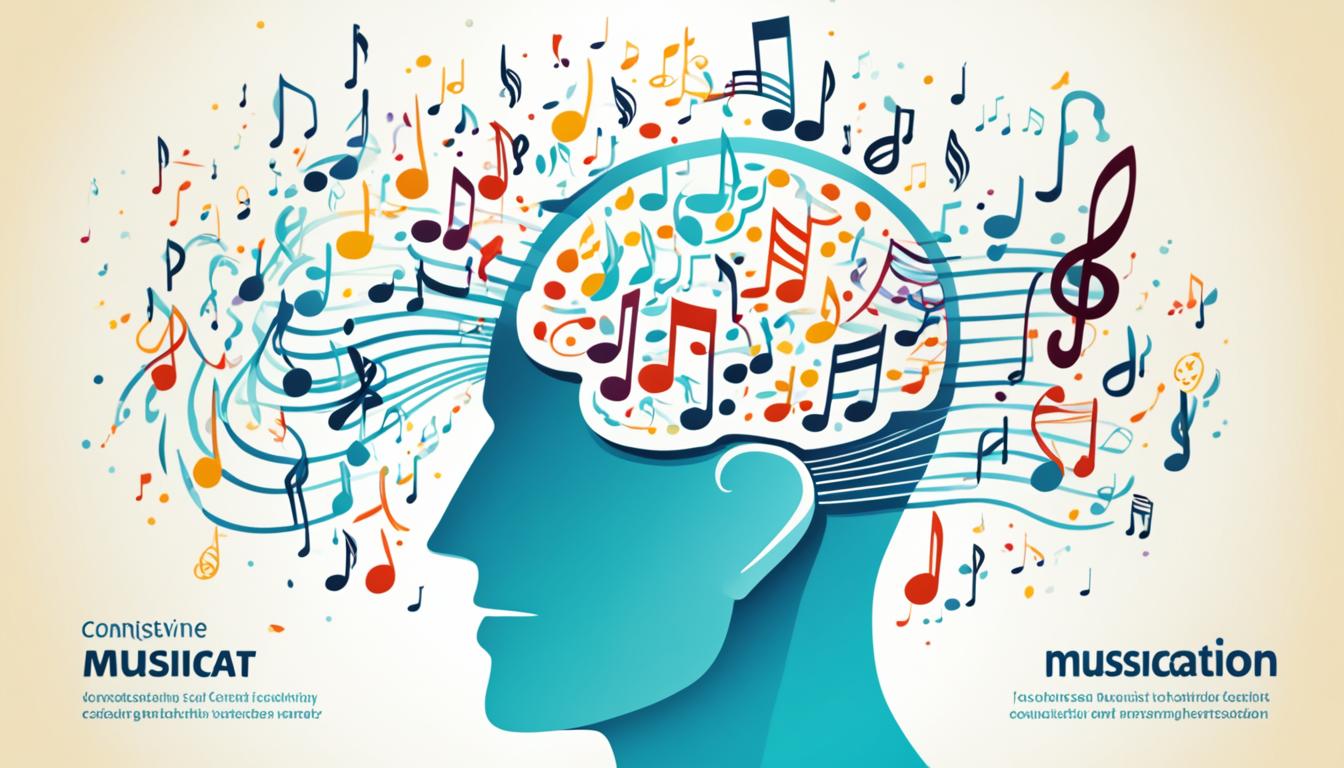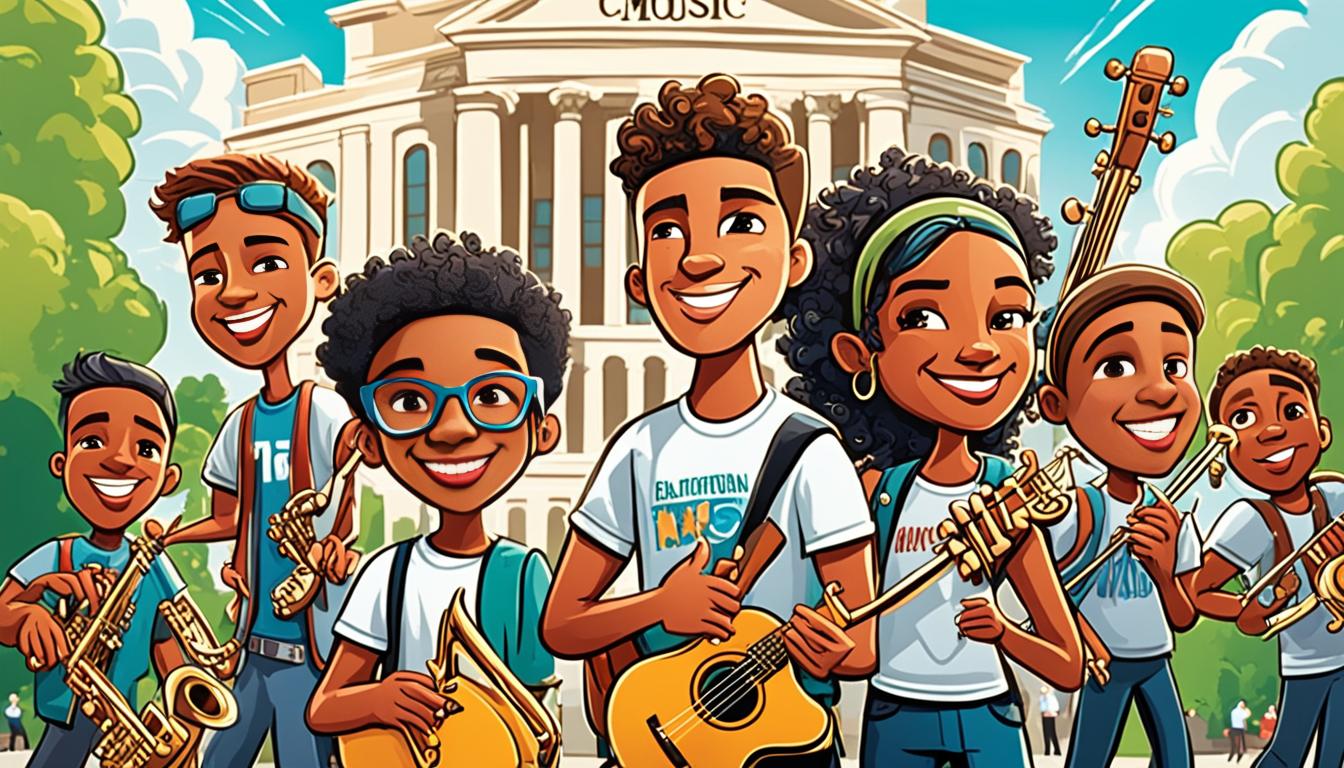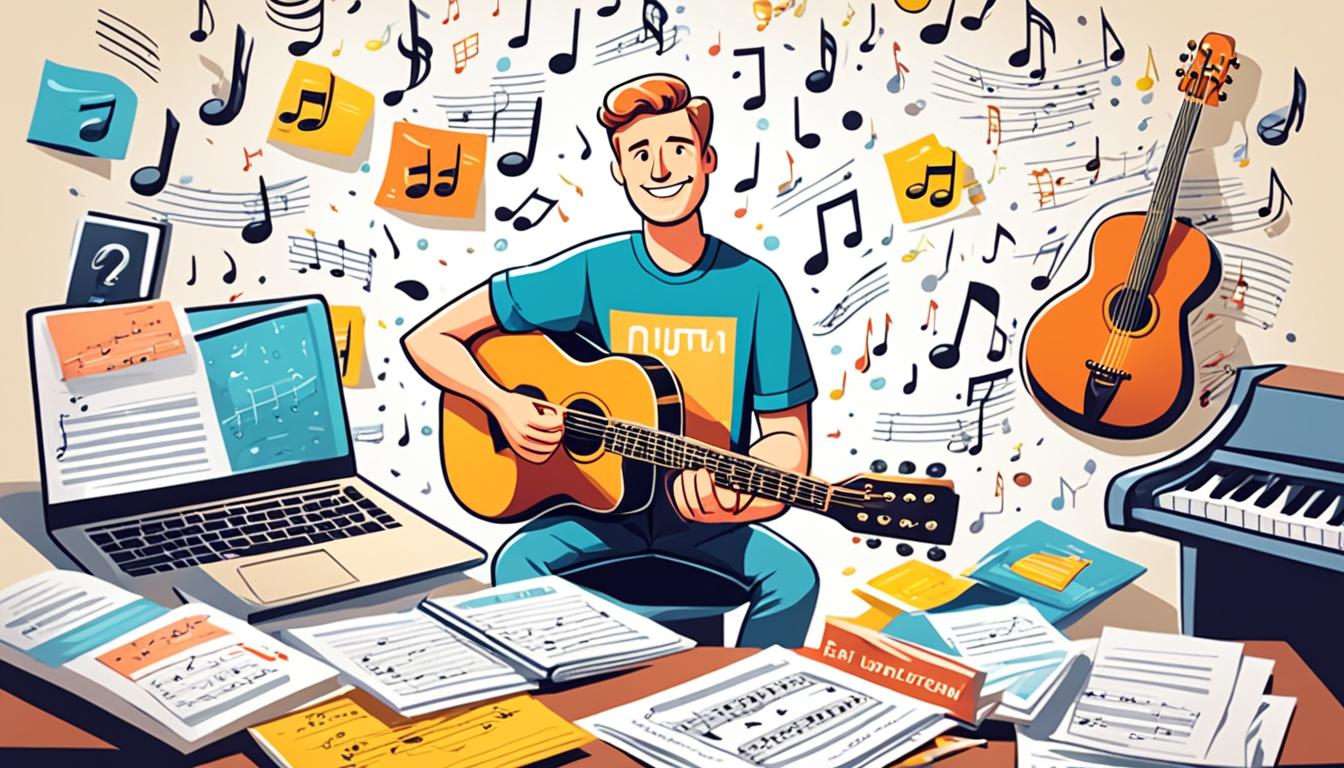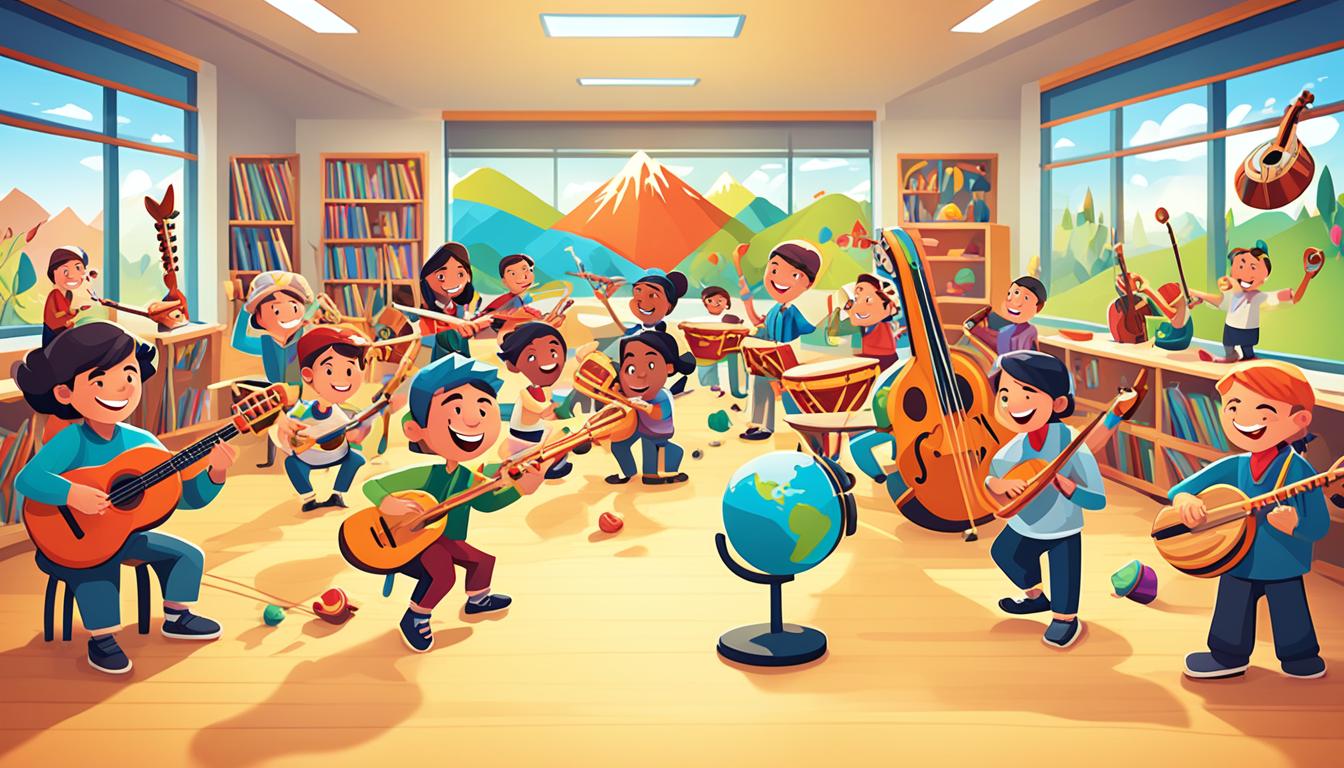In this article, we’ll dive into the rich world of global music education. We’ll look at the philosophies that guide how students learn music. We’ll cover methods from singing-based Kodály Method, which boosts pitch and sight-singing skills1, to Orff Schulwerk’s blend of rhythm and movement1. The Suzuki Method’s early start and family involvement will also be discussed1. Each offers unique ways to meet student needs.
We’ll see how music education shapes lives worldwide. Methods like Dalcroze Eurhythmics use music and dance for those who love to move1. Gordon’s Music Learning Theory focuses on hearing music in the mind’s ear, or audiation1.
Each approach highlights different strengths. Kodály emphasizes the voice’s role in learning music1. Orff fosters creativity with rhythm instruments and encourages students to improvise1. Suzuki builds a strong musical base from an early age with help from parents, focusing on string instruments1.
The chosen music varies too. Kodály uses folk songs to connect kids to their heritage1. Orff lets kids invent tunes, helping them find their musical voice. Suzuki uses a consistent set of pieces, rewarding students as they improve1.
By understanding global music education, teachers can offer enriched experiences. Music helps kids express feelings, ignite creativity, and think deeply2.
Key Takeaways:
- Global music education brings together different teaching styles, like Kodály, Orff Schulwerk, and Suzuki1.
- Each philosophy shines a light on aspects like voice training, invention, and early musical foundations1.
- Through music, students journey into emotion, creativity, and critical analysis2.
The Utilitarian Philosophy of Music Education
The Utilitarian Philosophy of Music Education focuses on the practical uses of music lessons. It teaches us that music has roles beyond just learning to play. It shows how music helps in school performance and teaching good behavior.
For instance, schools with strong music programs see higher SAT scores. Students also learn important values3. This proves that music lessons can help in many ways, not just in becoming a better musician.
The idea started in 1838 when Boston schools started teaching music. The goal was to improve church singing, moral values, health, and smarts3.
Many groups support this music education philosophy. The National Association for Music Education, VH1 Save the Music, and the National Association of Music Merchants all believe in music’s broad benefits3.
While this philosophy looks at music’s practical uses, there are other viewpoints. The Aesthetic Philosophy values the emotional side of music. It cares about the beauty of music itself, more than its usefulness3.
Bennett Reimer of Northwestern University developed this emotional view. He did this when music education funds were cut. He aimed to focus on the beauty of music3.
The Praxial Philosophy sees music as artistic and social. It views music as an activity and a cultural expression3. David Elliot believes music education should include active making and sharing. This view expands music education beyond classical music3.
Philip Alperson, Christopher Small, and Thomas Regelski also contributed to this theory. They emphasize music education’s focus on the act of making music. This approach encourages creativity and understanding of music’s role in society3.
The Aesthetic Philosophy of Music Education
The Aesthetic Philosophy of Music Education believes music is valuable on its own. It teaches us to love music just for being music, not for anything it can bring us. Music can touch our emotions and create special moments through sounds and how they’re expressed4. This way of thinking says we should learn and enjoy music for its beautiful parts. It’s about learning music skills and understanding, not about reaching some outside goal.
This idea doesn’t care much for the brainy or symbolic parts of music like some other views do. It thinks the way music makes us feel and what it makes us sense are really important4. Music can share and stir up deep feelings. It lets us say things we can’t find words for. Aesthetic music education lets students get to know their own reactions to music. They learn to share and understand feelings with music.
At the heart of this philosophy is the thought of “music for music’s sake”4. It sees music as a form of art. It suggests learning about and loving great music. This includes classical pieces that show off aesthetic values. This exposure helps students know a lot about music and how it can express feelings.
Learning music this way invites students to dive deep into music. They use their senses and feelings to connect with the music’s sounds and meanings4. This process is more than just thinking about music. It’s about feeling it and making it a part of you. Students are encouraged to listen closely, use their creativity, and react with their hearts and minds.
Students in aesthetic music education learn to see the details in musical performances4. They notice how each musician adds their own touch to a piece. They look at music’s parts, like melody and rhythm, and see how they make up the music’s beauty. By listening carefully and thinking about music, students understand the skill and art in making and performing music.
The Aesthetic Philosophy knows music is always changing. It supports including all types of music, from pop to folk to classical5. This openness helps students see how music is important across cultures. It shows music’s power to bring people from different places together.
This philosophy also likes mixing music education with other subjects like history and art5. Exploring how music connects with these areas helps students get a full picture of what music means. It makes their music experience even richer.
In the end, the Aesthetic Philosophy of Music Education sees music as a gift to be enjoyed for its beauty4. It pushes for expressing feelings through music and learning about wonderful music. It wants students to get into music deeply, feeling its emotional power and creating special moments4. By being open to different music and mixing it with other studies, students understand music’s role in culture. They see how it can inspire and bring us together.
The Praxial Philosophy of Music Education
Developed by David Elliott, the Praxial Philosophy sees music as an art and social action. It combines practicing music with understanding its theory6.
This approach stresses the value of knowing music’s cultural role. It shows how music influences and reflects society’s culture and social ties6.
Elliott believes music goes beyond just fun or showing feelings. It brings to life a person’s beliefs, motivations, and values6.
The Holistic Nature of Learning Music
According to this philosophy, learning music touches on everything. It includes active participation, critical thinking, and creating6.
It’s about gaining musical skills and knowledge. But, it’s also about growing personally and socially by making music6.
This perspective covers technical, emotional, social, and cultural sides of music. It looks into all aspects of musical experiences6.
The Role of Cultural Context in Music Education
The cultural backdrop is key in understanding music’s impact. Music connects deeply with a culture’s traditions and values6.
Studying music from different cultures widens students’ views. They learn to value the vast variety of human musical expression67.
By exploring various cultural musics, students enhance their musical abilities. They also build empathy, cultural awareness, and respect for other ways of life67.
Comparing Praxial Philosophies
The praxial philosophy focuses more on music-making as an active and meaningful student involvement. This contrasts with views like Kant’s formalism or the expressivist aesthetic cognitivist view6.
David Elliott’s praxial view is different from Thomas Regelski’s. Elliott opposes pure aesthetic views, presenting music as a complex human activity with multiple layers6.
Elliott’s view points out music’s deep connection to life. He suggests music is entwined with our consciousness and how we understand ourselves and the world6.
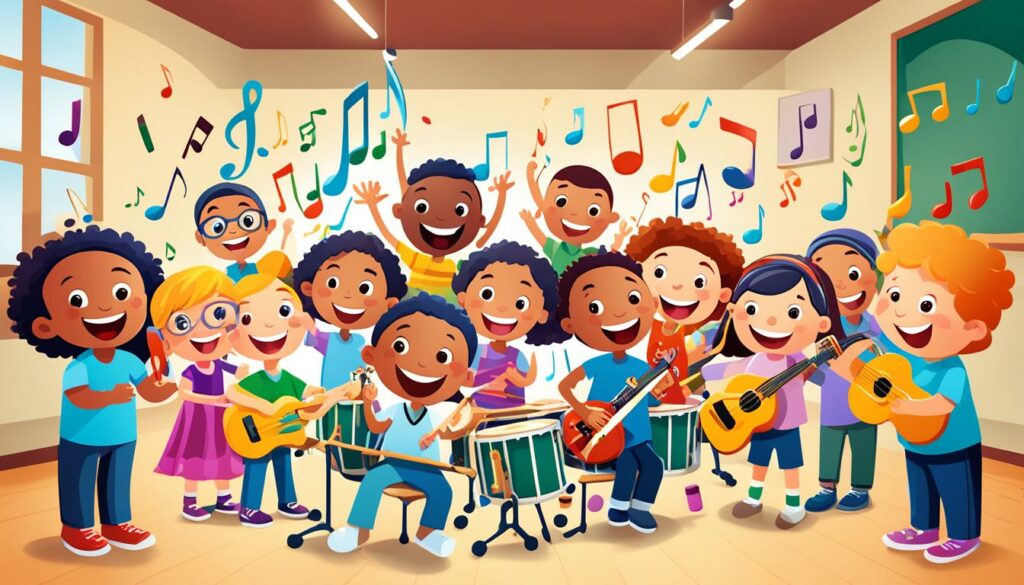
Table: Praxial Philosophy in Music Education
| Key Principles | Features |
|---|---|
| Emphasis on holistic learning | Integration of musical skills, personal growth, and cultural understanding6 |
| Active engagement | Students participate in meaningful music-making activities6 |
| Recognition of cultural context | Exploration and appreciation of music from diverse cultures67 |
| Emphasis on the complete context | Music as a reflection of human consciousness and experiences6 |
Importance of Student-Centered Learning in Music Education
Student-centered learning is key in music education because it lets students play a major part in their learning. They feel a strong connection and excitement about their studies. Through working together, students learn from each other, boosting their creativity and ability to find solutions8.
Collaboration is a big plus of this approach. It happens through talks and team projects. This way, students get involved and improve their communication and team skills89.
It also gets students ready for various roles like teaching, performing, and entrepreneurship8. They learn not just music, but also how to teach, perform, and handle business8.
Another important part is involving students in research and studies on their own. Through group work and projects, they sharpen their research abilities. This helps them grow academically and personally8.
A student-centered method also means giving top-notch recording services to help students reach their creative goals8. This support lets them explore and share their musical gifts, getting them ready for the music business8.
Additionally, this approach helps students by guiding them through research and using imagery in lessons. It focuses on thinking, feedback, and choosing the right music for each student. Educators provide an environment that supports learning well810.
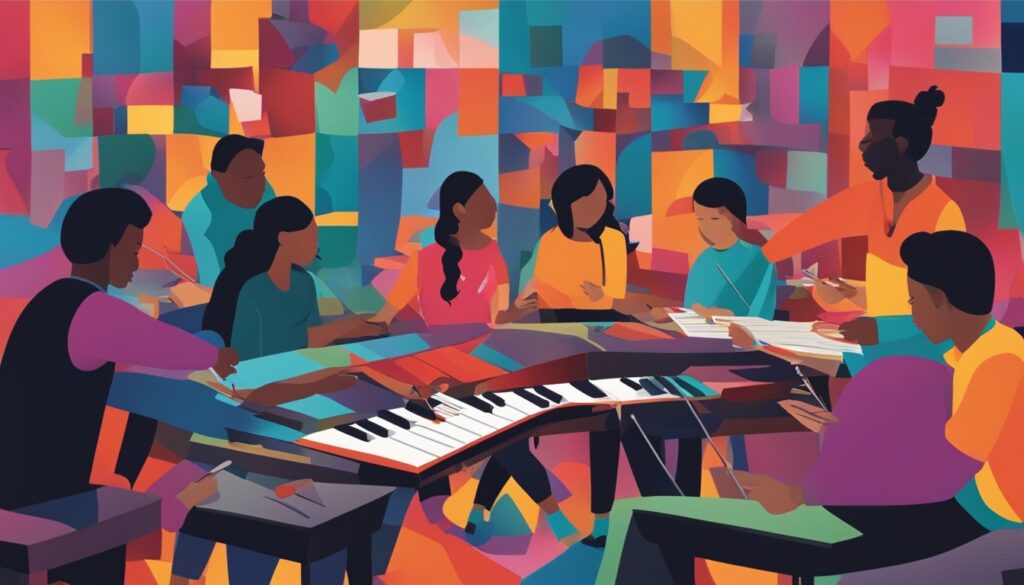
In summary, student-centered learning is vital in music education. It encourages active participation, teamwork, and developing diverse skills. Students take charge of their education, becoming comprehensive musicians and lifelong learners. They are set up for success in music and other life areas8910.
Music Education’s Impact on Mood and Quality of Life
Learning music does more than show students how to play or sing. It deeply improves their moods and life quality. Music education boosts well-being, academic success, and valuable skills11.
Studies confirm its big role in making students feel better, which then helps them do better in school. A study with 319 people showed that music lessons increase well-being and school success. It also found that feeling confident plays a role in this process11.
The benefits of music lessons are crucial today. The pandemic has vastly changed how we feel and act. US mental health lines saw calls skyrocket in April 2020. Even before, college students globally were already feeling more anxious and stressed11.
Music gives students a way to share their feelings and relax. It’s been seen that music students often feel less sad, anxious, and stressed. Music therapy is also a proven help for mental and health problems12.
Learning music teaches skills valuable in many areas. It requires discipline and creativity. These skills improve thinking, speaking, and emotional intelligence. Playing music with others also builds social skills and community feeling12.
Music lessons offer more than music skills. They provide emotional and beautiful experiences. They allow for creative expression and understanding different cultures. Being involved in music helps with mental health in kids and adults. It brings happiness by easing anxiety, depression, and mood changes12.
Impact of Music Education on Mood and Quality of Life
| Statistical Data | Findings |
|---|---|
| The study on the impact of music education11 | Music education has a significant positive impact on psychological well-being, improving academic performance |
| Research during the pandemic11 | Behavior and mental health have been significantly influenced, with increased calls to mental health hotlines |
| Impact of music education on mood12 | Music students experience lower levels of sadness, anxiety, and stress |
| Importance of marketable skills12 | Music education develops discipline, creativity, and critical thinking, enhancing cognitive and emotional intelligence |
| Overall mental health benefits12 | Music participation is associated with improved general mental health outcomes and reduced anxiety and depression |

The impact of music education on mood and life quality is clear. It boosts well-being, school success, and arms students with useful skills. By promoting the sharing of feelings, brain growth, and cultural insights, music education makes life better for people of all ages. Playing an instrument, singing, or engaging in music acts can truly lift and enrich lives.
The Role of Music in Cultural Understanding
Music is vital in society, crossing cultural lines and promoting understanding and empathy. It lets us see into different cultures, perspectives, and experiences. This section looks at music’s role in encouraging diversity and empathy.
Music and culture blend beautifully, showcasing each community’s heritage. Through music, we share and honor the stories, beliefs, and values of various cultures. It exposes us to the traditions and expressions that define different communities.
“Music education enhances students’ academic performance, social-emotional skills, and overall well-being, contributing to a more inclusive and culturally diverse society.”13
Research shows music education boosts academic performance and empathy in students. 68% of teachers say it helps students do better academically13. Also, 94% see improvements in students’ empathy and social skills13.
Songs like “We Shall Overcome” have inspired change and unity13. Music connects us, sharing emotions and stories across cultures. It helps us feel part of something bigger.
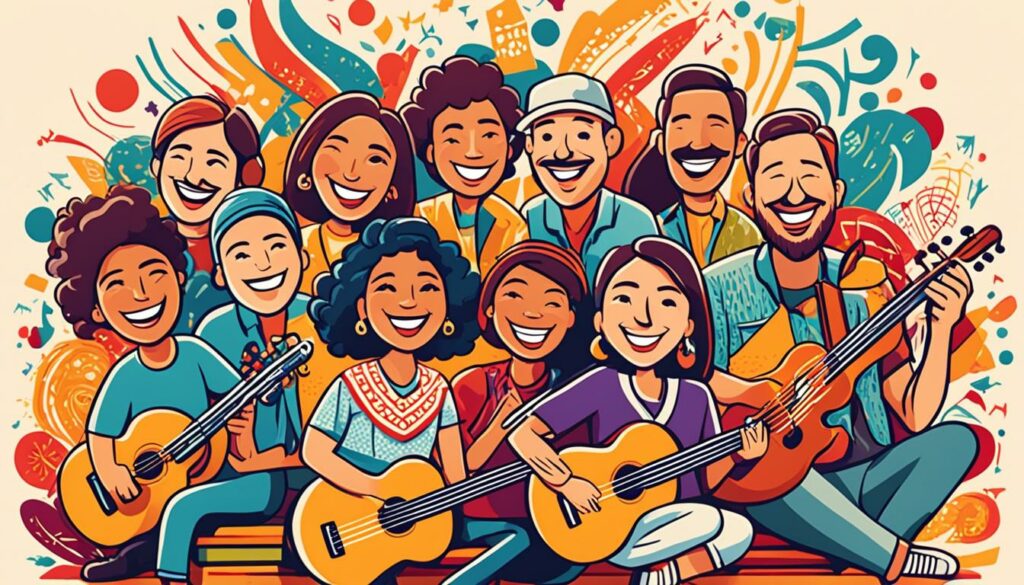
| Statistical Data | Source |
|---|---|
| Music education enhances academic performance and social-emotional skills. | Music education research13, |
| Music programs in schools lead to improved academic performance. | Music education research13, |
| 94% of teachers observed positive changes in students’ social-emotional well-being through music education. | Music education research13, |
Experiencing different cultures’ music broadens our perspective. It helps us appreciate the world’s diversity. By exploring musical traditions, we better understand and empathize with various cultures.
Music teachers should highlight different cultural music in lessons. This approach fosters an inclusive environment where students learn diverse viewpoints. Music can help students embrace global citizenship by understanding different cultures.
Music and Cultural Diversity
Music showcases cultural diversity, telling stories from around the globe. Celebrating different music traditions helps us see the value in cultural differences. It unites us and strengthens our cultural bonds.
Music bridges cultural gaps, fostering empathy and respect. Engaging with different genres expands our view and promotes inclusivity. This breaks down barriers, leading to understanding and peace.
| Emotion Recognition in Music by Different Cultures | Reference |
|---|---|
| Recognition of emotion in music by Japanese listeners: 78% | Cross-cultural research14, |
| Recognition of emotion in music by Western listeners: 69% | Cross-cultural research14, |
| Recognition of emotion in music by Hindustani listeners: 61% | Cross-cultural research14, |
Research found differences in how cultures perceive music emotionally. For instance, 78% of Japanese listeners identified emotions in music, compared to 69% of Western and 61% of Hindustani listeners14. This shows how diverse cultures respond to music uniquely.
We should include cultural diversity and empathy in music education. This enriches students’ understanding of the world. Through music, we can connect, understand, and celebrate humanity’s diverse cultures.
Engaging Diverse Learners Through Music Education
Music education helps engage different students and make classrooms more inclusive. It uses vocal music to bring students together, no matter their languages. This makes learning equal for everyone.
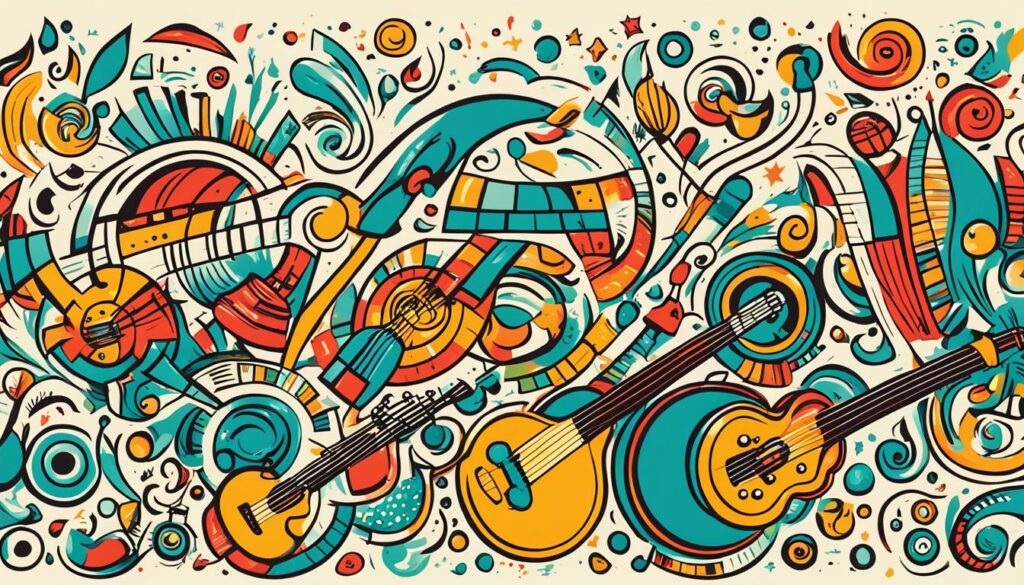
Singing in various languages lets students learn and join in equally. It helps them feel part of the group. This builds unity and respect for different cultures among students.
Music also supports students who find reading tough. It follows a learning method called Pestalozzian. This method teaches through experiences rather than just words.
Using music in class can better everyone’s learning. It boosts musical talent and thinking skills alike.
Studies and real-life cases15 prove music education’s wide benefits. It breaks down language walls and creates a place where everyone learns together. It also supports diverse learning styles, helping all students succeed.
Conclusion
Studying global music education philosophies is key for high-quality music lessons. The Utilitarian, Aesthetic, and Praxial views offer insights into music education’s value and goal16. History shows that music is vital to human cultures, crossing language and cultural lines. Music acts as a powerful means for sharing feelings, expressing oneself, and healing emotionally. Kids involved in music often show better thinking, spatial, memory, and problem-solving skills. This boosts their brain growth and helps with learning languages16.
Music plays a strong role in teaching about AIDS in Uganda, helping lower disease rates. For those with mental health challenges, music therapy offers a way to express feelings and heal16. Music communicates deep emotions and ideas beyond words, creating shared experiences. Thanks to tech advancements, music reaches worldwide, creating new styles16. Listening to music lowers stress, blood pressure, and aids anxiety and depression by triggering the release of pleasure-related hormones16.
Music education also brings benefits beyond the individual. According to the UNESCO Earth Charter, we are at a pivotal moment where we must decide our planet’s future17. Music teachers like Coleman teach about history, geography, and nature through music. This helps students understand their environment by linking music with other subjects. Coleman’s method promotes wider learning and creativity among kids17.
Dr. C. Victor Fung’s work on music education, based on Chinese philosophies of yin and yang, spotlights a comprehensive teaching approach18. Leading research in Tampa, Dr. Fung emphasizes the importance of social, multicultural, and global aspects in teaching music18. As Confucius noted, knowing how to adapt to change is crucial, underlining music education’s deeper effect18.
Using these philosophies can make music classes more enriching and enjoyable. To summarize, music education molds students’ growth, supports mental well-being, encourages understanding across cultures, and promotes care for our environment. Let’s adopt these varied ideas and improve music teaching for a brighter tomorrow.
FAQ
What is the Utilitarian Philosophy of Music Education?
What is the Aesthetic Philosophy of Music Education?
What is the Praxial Philosophy of Music Education?
Why is student-centered learning important in music education?
How does music education impact mood and quality of life?
What role does music play in cultural understanding?
How does music education engage diverse learners?
Why is it important to explore global music education philosophies?
Source Links
- https://musicjunkiestudios.com/a-guide-to-music-education-philosophies/ – A Comprehensive Guide to Music Education Philosophies
- https://www.k-state.edu/musiceducation/eportfolio/behrlich/Bobbi_Ehrlich_B/Philosophy_of_Education.html – Philosophy of Music Education
- https://www.victoriaboler.com/blog/three-philosophies-of-music-education – 3 Philosophies of Music Education — Victoria Boler
- https://maydaygroup.org/2003/04/implications-of-aesthetic-versus-praxial-philosophies-of-music-for-curriculum-theory-in-music-education/ – Implications of Aesthetic versus Praxial Philosophies of Music for Curriculum Theory in Music Education – Mayday Group
- https://digitalcommons.lib.uconn.edu/cgi/viewcontent.cgi?article=1737&context=vrme – Music Education in Broad Perspective
- https://muse.jhu.edu/article/43657 – Project MUSE – Perspectives on Practice: A Pragmatic Comparison of the Praxial Philosophies of David Elliott and Thomas Regelski
- https://www.davidelliottmusic.com/praxial-music-education/music-and-identity/ – Music and Identity
- http://www.giovanniperezflute.com/new-page – Teaching Philosophy — Giovanni A. Pérez
- https://onlinedegrees.sandiego.edu/teacher-centered-vs-student-centered-learning/ – Complete Guide to Student-Centered vs. Teacher-Centered Learning
- http://www.johnleebonner.com/teaching-music-philosophy.html – Teaching Music Philosophy
- https://www.ncbi.nlm.nih.gov/pmc/articles/PMC8863131/ – Exploring the Impact of Music Education on the Psychological and Academic Outcomes of Students: Mediating Role of Self-Efficacy and Self-Esteem
- https://www.frontiersin.org/journals/psychology/articles/10.3389/fpsyg.2022.938090/full – Frontiers | Impact of Music Education on Mental Health of Higher Education Students: Moderating Role of Emotional Intelligence
- https://www.savethemusic.org/blog/how-does-music-affect-society/ – Impact of Music on Society – Sociological Effects
- https://www.ncbi.nlm.nih.gov/pmc/articles/PMC4321137/ – Cross-cultural perspectives on music and musicality
- https://files.eric.ed.gov/fulltext/EJ1061811.pdf – PDF
- https://www.linkedin.com/pulse/music-philosophy-exploring-its-profound-impact-beatrice-beatrice – Music in Philosophy: Exploring its Profound Impact on Humanity
- https://act.maydaygroup.org/volume-19-issue-1/an-environmental-philosophy-for-music-education-based-on-satis-colemans-1878-1961-writings-on-music-and-nature/ – An Environmental Philosophy for Music Education Based on Satis Coleman’s (1878–1961) Writings on Music and Nature – ACT
- https://jeremiwedwards.org/445844017/447431178 – Teaching Philosophy | jeremiwedwards.org


